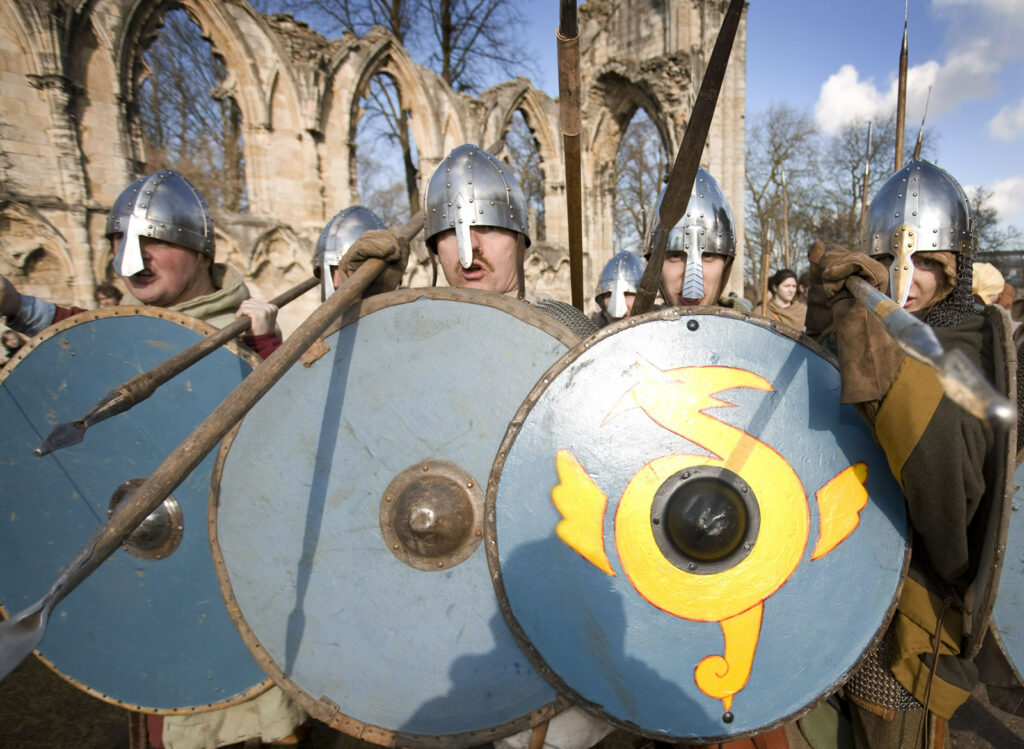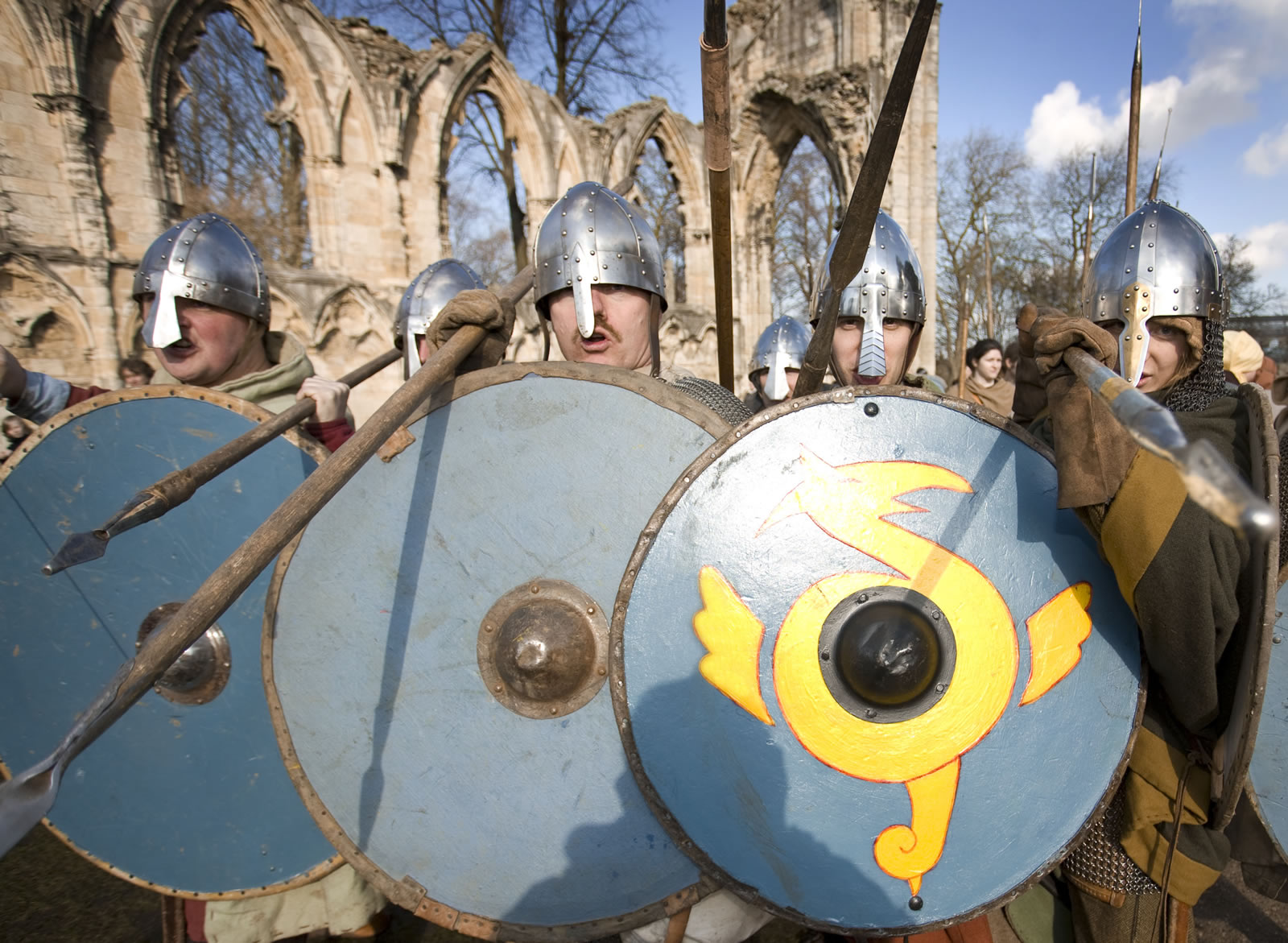Welcome to Yorkshire
Published on June 8th, 2017
•
Viking Battles in Yorkshire
The Vikings were warriors. From the end of the 8th century onwards, people from Scandinavia began to attack England, most notably the monastery on Lindisfarne, Northumbria, in 793.
Before 850, Viking attacks were short raids, but in the winter of that year, the Viking army remained in Britain. The strength of the army grew, and in 866 the Vikings captured the city of York. The Vikings ruled parts of England until 954. Scandinavian influence continued when the Danish king Cnut became king of England in 1016. The last great Viking invasion force was defeated in battle at Stamford Bridge in 1066.
Ripon Cathedral
In 947 the Northumbrian leaders had submitted to the English King Eadred (one of the grandsons of Alfred the Great) at Tanshelf (modern-day Pontefract, where the remains of an Anglo-Saxon church can still be seen between the castle and All Saints church).
Built in stone by continental masons at a time when most buildings in England were of timber, it must have been a mighty and impressive sight; remarkably, the crypt of this church has survived and can still be visited today.
Castleford
In 948, having raided Northumbria and burned the minster at Ripon in the Yorkshire Dales, King Eadred's army was returning south, following the route of the old Roman road, which here crossed the treacherous flood plain of the Aire. Erik Bloodaxe's army issued suddenly out of York and caught the rearguard of Eadred's force at the river crossing, inflicting a ‘great slaughter'. No other details of the battle are known, but it must have taken place hereabouts. Eadred was outraged and threatened a renewed invasion of Northumbria.
At this the Northumbrians took fright and disowned Erik, who found himself increasingly isolated in the years that followed. His greatest fighting days long behind him, Bloodaxe died in 954 in the Stainmore Pass, possibly in a final flight from a hostile Northumbria.
The exact location of the battle is unknown, but the address and grid reference given here marks the point at which Barnsdale Road departs from the course of the old Roman road, not far from the old river crossing; it is accessible by public footpaths along the Aire to the west and a canal to the east.
There is on-road parking in Allerton Bywater. Further off is the RSPB reserve at Fairburn Ings, with a car park and toilet facilities. We recommend the use of an OS map to find the relevant locations. The area affords various pleasant riverside walks that allow the visitor to appreciate the marshy conditions hereabouts, which must have hampered the homeward progress of Eadred's army.
Fulford
In September 1066 the Norwegian king Harald Hardrada sailed up the Ouse towards York with an invasion force of 300 ships. Accompanying him was Tostig Godwinson, the exiled Earl of Northumbria and brother of the English king, Harold Godwinson. The armies of Hardrada and Tostig left their fleet at Riccall, 10 miles south of York, and advanced on the city.
On 20th September they were met a mile and a half south of its walls by Earls Edwin and Morcar, who had raised an army to counter the Viking threat. The location was Fulford, an area of open fields and marshland. The English army gathered on higher ground north of the Germany Beck to intercept the Viking force as it marched on the road towards York.
The battle itself is thought to have been short and fierce, with the English troops driven back from their positions, some fleeing towards the city, others outflanked and driven into the Ouse to drown. York surrendered, but no occupation followed; instead an agreement was reached whereby the Vikings would receive hostages and tribute at Stamford Bridge, retiring in the meantime to their camp at Riccall.
Clifford's Tower and Baile Hill, York
These sites are the locations of two motte and bailey castles built by William the Conqueror in 1068-9 to establish control in the north of England. In September 1069, Swein of Denmark sent a fleet up the Humber, and the Northumbrians rose in revolt against their Norman overlords. Attempting to hinder the advance on the castle, the Normans set fire to the houses in the city, but the flames grew out of control. The garrison was overwhelmed, the castles captured and dismantled. William returned north to re-establish his control, and to buy off the invading Danes. The subsequent ‘harrying of the North' ended Northumbrian resistance. By the early 13th century, the castle at Baile Hill fell out of use and the land was transferred to the archbishop.
The stone keep, known as Clifford's Tower, was built between 1245 and 1272 to update the defences from wooden structures to stone. As the need for an important fortress in the north diminished, Clifford's Tower was allowed to slip into decay. During the Civil War, the whole castle was garrisoned by Royalists troops, so the tower needed to be completely repaired. Clifford's Tower suffered damage during the siege of York in 1644. Clifford's Tower has 55 entrance steps, uneven surfaces and hazardous walkways.
St Andrew's Church, Middleton
One of the finest surviving examples of monumental Anglo-Scandinavian artwork in England is the cross found at Middleton. Tenth-century Danish lords adopted the local tradition of erecting stone sculpture incorporating Christian iconography in order to demonstrate their power.
At a time of constant conflict between Saxons and Vikings, some of the sculptures emphasised the military power of the Danish lord. The Middleton Cross shows a warrior wearing a helmet, and knife (or sword) on his belt. He is surrounded by his spear, sword, axe and shield. It was once thought this depicted a Viking lying is grave, but the cross is now interpreted to show a local lord sitting on his thrown. The circular shapes above his shoulders are the knots on the back of his throne. His weapons are other symbols of his status; his military superiority is very much part of his power.
Stamford Bridge. Battle of Stamford Bridge, 25 Sep 1066
King Harold of England was preparing the south of the country for an anticipated invasion by Duke William of Normandy when news reached him of a hostile Viking force encamped just outside York. Turning at once to the north, he marched his army day and night, arriving at Stamford Bridge on 25th September with such suddenness that the Vikings were taken completely by surprise. Harald Hardrada and his allies had arrived at Stamford Bridge to collect the tribute and hostages they had demanded of the English army, so lately defeated at the Battle of Fulford, and were unprepared for the powerful force that awaited them. Some sources suggest that some of the Viking troops had been left back at the Riccall camp, along with many of the weapons and much of the armour. Details of the ensuing battle are sketchy, but it seems that the warlike Hardrada took the decision to fight rather than retreat; his troops on the west bank of the Derwent were to hold the crossing-point until his forces could be organised on the east bank. Some accounts tell of a single Viking warrior who held the bridge against the English until he was stabbed from below by a spearman. Both Hardrada and the rebel Tostig were slain in the battle, Hardrada struck in the throat by an English arrow. The Viking army was decimated, but Hardrada's son and other survivors were allowed to return to Norway on condition that they never return. Stamford Bridge was a great victory for King Harold, but the toll that it took on his army may have contributed to his defeat at the Battle of Hastings less than three weeks later.

Comments
0 Contributions
No comments yet. Be the first to start the conversation!